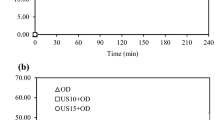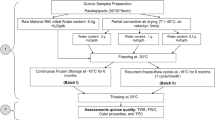Abstract
Freezing characteristics (freezing time, latent heat of fusion of ice, and freezable water content) and quality parameters (drip loss, color, firmness, and l-ascorbic acid content) of broccoli (osmodehydrofrozen and ultrasound-assisted osmodehydrofrozen) during frozen storage were investigated. Freezing time, latent heat of fusion of ice, and freezable water content of osmodehydrated samples decreased significantly compared to samples which were not under osmotic dehydration. The changes of drip loss, color, firmness, and l-ascorbic acid content of osmodehydrofrozen and ultrasound-assisted osmodehydrofrozen broccoli during frozen storage were inhibited markedly compared to samples which were not submitted to osmotic dehydration before freezing. Compared to osmotic dehydration, the ultrasound-assisted osmotic dehydration shortened the needed dehydration time and better preserved the firmness and l-ascorbic acid content after osmotic dehydration pretreatment. In addition, the ultrasound-assisted osmotic dehydration minimized the drip loss and loss of l-ascorbic acid content and better maintained the color and firmness when stored at −25 °C for 6 months. These findings indicate that it is promising to apply ultrasound-assisted osmodehydrofreezing in freezing and frozen storage of food.




Similar content being viewed by others
References
Agnelli, M., Marani, C., & Mascheroni, R. (2005). Modelling of heat and mass transfer during (osmo) dehydrofreezing of fruits. Journal of Food Engineering, 69(4), 415–424.
Bellary, A. N., Sowbhagya, H., & Rastogi, N. K. (2011). Osmotic dehydration assisted impregnation of curcuminoids in coconut slices. Journal of Food Engineering, 105(3), 453–459.
Buggenhout, S. V., Messagie, I., Maes, V., Duvetter, T., Van Loey, A., & Hendrickx, M. (2006). Minimizing texture loss of frozen strawberries: effect of infusion with pectinmethylesterase and calcium combined with different freezing conditions and effect of subsequent storage/thawing conditions. European Food Research and Technology, 223(3), 395–404.
Cárcel, J., Benedito, J., Rosselló, C., & Mulet, A. (2007). Influence of ultrasound intensity on mass transfer in apple immersed in a sucrose solution. Journal of Food Engineering, 78(2), 472–479.
Conway, J., Castaigne, F., Picard, G., & Vovan, X. (1983). Mass transfer considerations in the osmotic dehydration of apples. Canadian Institute of Food Science and Technology Journal, 16(1), 25–29.
Campbell, L. H., & Brockbank, K. G. (2012). Culturing with trehalose produces viable endothelial cells after cryopreservation. Cryobiology, 64(3), 240–244.
Crowe, J. H., Crowe, L. M., & Chapman, D. (1984). Preservation of membranes in anhydrobiotic organisms: the role of trehalose. Science (New York, NY), 223, 701–703.
Crowe, J. H., Hoekstra, F. A., Nguyen, K. H., & Crowe, L. M. (1996). Is vitrification involved in depression of the phase transition temperature in dry phospholipids? Biochimica et Biophysica Acta (BBA)-Biomembranes, 1280(2), 187–196.
De la Fuente-Blanco, S., Riera-Franco de Sarabia, E., Acosta-Aparicio, V., Blanco-Blanco, A., & Gallego-Juárez, J. (2006). Food drying process by power ultrasound. Ultrasonics, 44, e523–e527.
Dermesonlouoglou, E. K., Giannakourou, M., & Taoukis, P. S. (2007). Stability of dehydrofrozen tomatoes pretreated with alternative osmotic solutes. Journal of Food Engineering, 78(1), 272–280.
Dermesonlouoglou, E. K., Pourgouri, S., & Taoukis, P. S. (2008). Kinetic study of the effect of the osmotic dehydration pre-treatment to the shelf life of frozen cucumber. Innovative Food Science & Emerging Technologies, 9(4), 542–549.
Fernández-León, M. F., Fernández-León, A., Lozano, M., Ayuso, M., & González-Gómez, D. (2012). Altered commercial controlled atmosphere storage conditions for ‘Parhenon’ broccoli plants (Brassica oleracea L. var. italica). Influence on the outer quality parameters and on the health-promoting compounds. LWT - Food Science and Technology, 50(2), 665–672.
Fernández, P. P., Otero, L., Guignon, B., & Sanz, P. D. (2006). High-pressure shift freezing versus high-pressure assisted freezing: effects on the microstructure of a food model. Food Hydrocolloids, 20(4), 510–522.
Fernandes, F. A., Gallão, M. I., & Rodrigues, S. (2009). Effect of osmosis and ultrasound on pineapple cell tissue structure during dehydration. Journal of Food Engineering, 90(2), 186–190.
Giannakourou, M., & Taoukis, P. (2003). Stability of dehydrofrozen green peas pretreated with nonconventional osmotic agents. Journal of Food Science, 68(6), 2002–2010.
Gonçalves, E. M., Abreu, M., Brandão, T. R., & Silva, C. L. (2011). Degradation kinetics of colour, vitamin C and drip loss in frozen broccoli (Brassica oleracea L. ssp. italica) during storage at isothermal and non-isothermal conditions. International Journal of Refrigeration, 34(8), 2136–2144.
Gonçalves, E. M., Cruz, R., Abreu, M., Brandão, T., & Silva, C. L. (2009). Biochemical and colour changes of watercress (Nasturtium officinale R. Br.) during freezing and frozen storage. Journal of Food Engineering, 93(1), 32–39.
Goula, A. M., & Lazarides, H. N. (2012). Modeling of mass and heat transfer during combined processes of osmotic dehydration and freezing (osmo-dehydro-freezing). Chemical Engineering Science, 82, 52–61.
Jain, N. K., & Roy, I. (2010). Trehalose and protein stability. Current Protocols in Protein Science, chapter 4, 4.9. 1–4.9. 12.
Keck, A. S., & Finley, J. W. (2004). Cruciferous vegetables: cancer protective mechanisms of glucosinolate hydrolysis products and selenium. Integrative Cancer Therapies, 3(1), 5–12.
Lee, C. W., Waugh, J. S., & Griffin, R. G. (1986). Solid-state NMR study of trehalose/1,2-dipalmitoyl-sn-phosphatidylcholine interactions. Biochemistry, 25(13), 3737–3742.
Lee, S. L., Debenedetti, P. G., & Errington, J. R. (2005). A computational study of hydration, solution structure, and dynamics in dilute carbohydrate solutions. Journal of Chemical Physics, 122(20), 204511–204520.
Li, B., & Sun, D. W. (2002). Novel methods for rapid freezing and thawing of foods—a review. Journal of Food Engineering, 54(3), 175–182.
Lowithun, N., & Charoenrein, S. (2009). Influence of osmodehydrofreezing with different sugars on the quality of frozen rambutan. International Journal of Food Science & Technology, 44(11), 2183–2188.
Martínez‐Monzó, J., Martínez‐Navarrete, N., Chiralt, A., & Fito, P. (1998). Mechanical and structural changes in apple (var. Granny Smith) due to vacuum impregnation with cryoprotectants. Journal of Food Science, 63(3), 499–503.
Martins, R., & Silva, C. (2002). Modelling colour and chlorophyll losses of frozen green beans (Phaseolus vulgaris, L.). International Journal of Refrigeration, 25(7), 966–974.
Monsalve‐Gonález, A., Barbosa‐Cánovas, G. V., & Cavalieri, R. P. (1993). Mass transfer and textural changes during processing of apples by combined methods. Journal of Food Science, 58(5), 1118–1124.
Moraga, G., Martínez-Navarrete, N., & Chiralt, A. (2006). Compositional changes of strawberry due to dehydration, cold storage and freezing–thawing processes. Journal of Food Processing and Preservation, 30(4), 458–474.
Nowacka, M., Wiktor, A., Śledź, M., Jurek, N., & Witrowa-Rajchert, D. (2012). Drying of ultrasound pretreated apple and its selected physical properties. Journal of Food Engineering, 113(3), 427–433.
Ohtake, S., & Wang, Y. J. (2011). Trehalose: current use and future applications. Journal of Pharmaceutical Sciences, 100(6), 2020–2053.
Oku, K., & Okazaki, M. (1998). Allowable amount and metabolism of trehalose in Japanese population. Collection From The First Trehalsoe Symposium, pp 16–30.
Ramallo, L. A., & Mascheroni, R. H. (2010). Dehydrofreezing of pineapple. Journal of Food Engineering, 99(3), 269–275.
Torreggiani, D., & Bertolo, G. (2001). Osmotic pre-treatments in fruit processing: chemical, physical and structural effects. Journal of Food Engineering, 49(2–3), 247–253.
Torreggiani, D., Forni, E., & Rizzolo, A. (1988). Osmotic dehydration of fruit. Journal of Food Processing and Preservation, 12(1), 27–44.
Tregunno, N., & Goff, H. (1996). Osmodehydrofreezing of apples: structural and textural effects. Food Research International, 29(5), 471–479.
Wang, L. L., Chen, Y. M., & Li, Z. G. (2013). The effects of freezing on soybean microstructure and qualities of soymilk. Journal of Food Engineering, 116(1), 1–6.
Wu, L., Orikasa, T., Tokuyasu, K., Shiina, T., & Tagawa, A. (2009). Applicability of vacuum-dehydrofreezing technique for the long-term preservation of fresh-cut eggplant: effects of process conditions on the quality attributes of the samples. Journal of Food Engineering, 91(4), 560–565.
Xin, Y., Zhang, M., & Adhikari, B. (2013). Effect of trehalose and ultrasound-assisted osmotic dehydration on the state of water and glass transition temperature of broccoli (Brassica oleracea L. var. botrytis L.). Journal of Food Engineering, 119(3), 640–647.
Acknowledgments
The authors gratefully acknowledge the financial support provided by the China National Natural Science Foundation (contract no. 21176104) and Priority Academic Program Development of Jiangsu Higher Education Institutions to carry out this project.
Author information
Authors and Affiliations
Corresponding author
Rights and permissions
About this article
Cite this article
Xin, Y., Zhang, M. & Adhikari, B. Freezing Characteristics and Storage Stability of Broccoli (Brassica oleracea L. var. botrytis L.) Under Osmodehydrofreezing and Ultrasound-Assisted Osmodehydrofreezing Treatments. Food Bioprocess Technol 7, 1736–1744 (2014). https://doi.org/10.1007/s11947-013-1231-4
Received:
Accepted:
Published:
Issue Date:
DOI: https://doi.org/10.1007/s11947-013-1231-4




